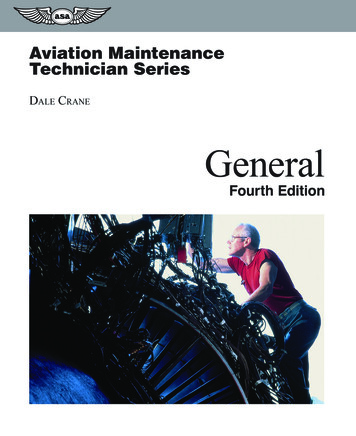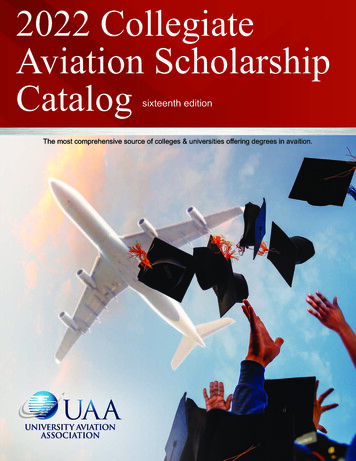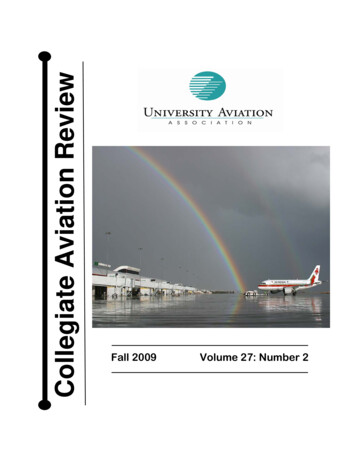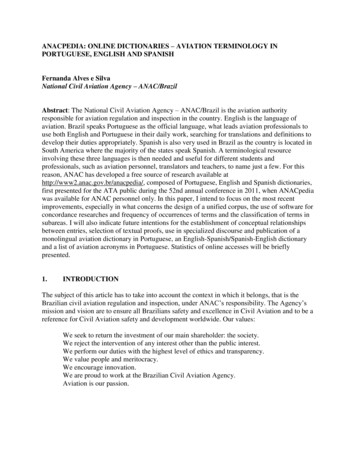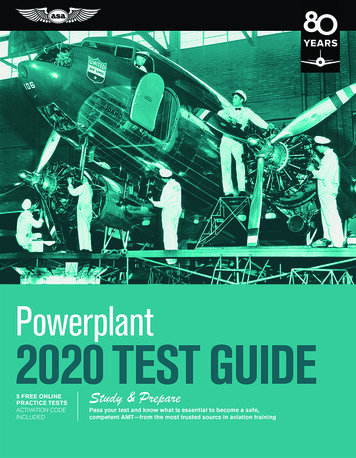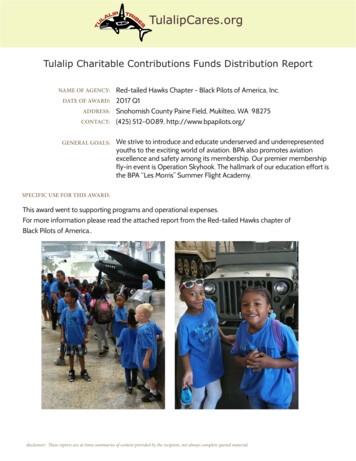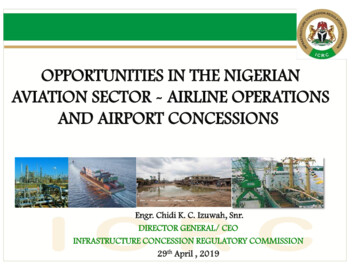
Transcription
OPPORTUNITIES IN THE NIGERIANAVIATION SECTOR - AIRLINE OPERATIONSAND AIRPORT CONCESSIONSEngr. Chidi K. C. Izuwah, Snr.DIRECTOR GENERAL/ CEOINFRASTRUCTURE CONCESSION REGULATORY COMMISSION29th April , 2019
Leadership CommitmentEXCERPTS OF SPEECH OF PRESIDENTMUHAMMADU BUHARI ONAUGUST 23, 2015“ .We also have a huge infrastructure deficit for which werequire foreign capital and expertise to supplement whateverresources we can marshal at home. In essence, we seek publicprivate partnerships in our quest for enhanced capital andexpertise.”2
Transportation & Economic DevelopmentAMERICA HAS GOOD ROADS, NOTBECAUSE AMERICA IS RICH, BUTAMERICA IS RICH BECAUSE IT HASGOOD ROADS - John F KennedyFormer US President.The implication of this quote from the60s is an eternal economic truism. Nocountry can become economicallybuoyant without a good infrastructurenetwork especially a good road, waterand aviation network – intermodalnetwork.4
Introducing.Nigeria centre of the world
Africa’s Most Formidable CV – Past andPresent Largest Economy in Africa and First TV Broadcast in AfricaMandela hid in Nigeria for 6 months to escape the Apartheid RegimePrevious longest Bridge in Africa (11.8 Kms) – Egypt nowLargest Black Country in the World – 190 – 200 MillionLargest Entrepreneurial Population in Africa, Large Mobile Phone User BaseThird Largest Movie Industry in the World – Now 2ndDiversifying Economy With Growing Non Oil Sector – 51% Services, Agric22%, Industry 26%, Oil 15% Richest Man in Africa – Aliko Dangote Leading Destination for Investment in Africa – UNCTAD IF YOU ARE NOT IN NIGERIA, YOU ARE NOT IN AFRICA
PRESENTATION OUTLINE Case for ActionWhy Aviation MattersAviation Sector Transformation ProgramAirline Opportunities/National CarrierAirports Plus – MRO, ALC etcNigeria’s Legal and Regulatory Framework for PPPs
Case for Action
PRESENTATION OUTLINEWe have a huge Infrastructure Business Opportunityor Emergency or Problem – TYC RecordsGovernment does not have all the resourcesgovernment and private sector working together isnot an option.its mandatory
Real GDP Growth Trends Real GDP growth remains weaker than pre-recession levels of 5-6% per annumSource: NBS, Afrinvest Research10
Components of Proposed 2019 Budget The proposed 2019 budget of 8.83tn ( 29bn) is 3.2% lower than the 9.12tnbudget of 2018. 21.5bn 7.4bn 28.9bnN2.3tnN8.8tnDebt ServiceTotal Expenditure 6.7bnN2.0tn 13.2bn 1.6bnN0.5tnN4.0tnRecurrent ExpenditureStatutory TransfersCapital ExpenditureSource: Budget Office, Afrinvest Research; Exchange Rate: 1/N30511
Federal Government Revenue Profile Budgeted and estimated actual revenue consist of Oil and Gas revenue, Non-Oilrevenue and Independent revenueBudget 23.5bnActual 22.9bn 16.8bn 11.4bn 11.1bn 8.8bn2017Source: Budget Office, Afrinvest Research; Exchange Rate: 1/N3052018201912
Domestic financial depth: Nigeria fairs poorly on domesticsavings, investments and government spending vs peersDomestic SavingsDomestic Savings 2015, % of GDPInvestmentInvestment 2015, % of GDPGovernment SpendingGov. Spending 2016, % of GDP1
Private Capital is Available
Private Capital in Lagos15
Why Aviation Matters
Aviation Sector ContributionsComparison
Ethiopia GTP II - Aviation Sector tocontribute 25% of GDP by Mid 2020
The Aviation Industry - DubaiDubai (2 Airports) In 2012: Total Passengers processed 57.7 m Aviation industry contribution to GDP - 20%; estimated torise to 32% in 2020 In 2013: Passengers processed rose to 65.4% Connects to 149 cities all over the world Generated revenue of 10.2 billion Supported 157,000 jobs Industry estimated contribution to GDP to rise to 32% in2020Sources: ATAG – Aviation Benefits Beyond Borders, 2014; Oxford Economics: Economic Benefits from Air Transport in Nigeria, 201219
The Aviation Industry - NigeriaNigerian Aviation Industry In 2015: Aviation industry supports 254,500 jobs Contributes US 940 million (N184.7 billion) to national GDP. Of this sum, 49% (i.e. US 462 million or N90.8 billion) is a directoutput of the aviation sector (via airports, airlines and ground services) Indirectly jobs, 51% (via the supply chain). Additional US 464 million (N91.2 billion) is derived from tourism,which raises the overall contribution to US 1.4 billion (N275.9 billion). In 2010 - Total Passengers: 8.3 m (4.2m domestic passengers;Contribution to GDP – 0.4%Sources: ATAG – Aviation Benefits Beyond Borders, 2014; Oxford Economics: Economic Benefits from AirTransport in Nigeria, 2012
The Aviation Industry - Nigeria
The Aviation Industry - Nigeria
The Aviation Industry - Nigeria
Aviation Sector TransformationProgram
ECOSYSTEM SCOPE1. Four International Airports Murtala Mohammed International Airport Lagos Nnamdi Azikwe International Airport Abuja Port Harcourt International Airport Port Harcourt Mallam Aminu Kano International Airport Kano.2. Aviation Leasing Company (ALC): Setting up of aPPP JV company that will provide aircrafts andengines to airlines on favourable lease financialterms over a period of time.
PROJECTS DESCRIPTION3. Maintenance Repair and Overhaul(MRO): The establishment of a facilityfor aircrafts maintenance that includesrepairs, inspection, alteration and supplyof parts4. Aerotropolis (Airport City): Theplanning and development of supportingamenities and facilities around theairport
PROJECTS DESCRIPTION5. National Carrier: The establishment ofnational airline for the country6. Six Cargo/Agro Allied Terminals: To belocated in each of the geo-political zones:The development of specialized airports forcargo handling and agricultural products
Airline Opportunities and theNational Carrier
Airlines Force Field Analysis Great Population Airport Facilities and Services Requiring Significant Upgrade – WA has left usbehind Uncoordinated last mile service Cost of Financing and Aircraft Leases Aviation Fuel Cost and Availability Access to FX and Lack of MRO Destination Nigeria Airport Opening Times and Facilities – Low Utilization High Airport and Other Charges Fly Nigeria Policy or Act
National Carrier Project
Nigeria’s new national carrier huge PPPopportunityThe Emirates Group in Dubai started about 40 yearsago with 2 old B737 leased from PakistaniInternational AirlinesIn 2016/17 they accrued revenues of 25.8 Billion USD with150,000 employeesIn comparison, Nigeria in 2016/17 sold on average 1.4Million Barrels per day, at a rate of 40 USD per barrel 20.4Billion USD per year.34
Abuja and Nigeria are strategically located at the crossroads of global internationaltradeRussia & CISEuropeNorth AmericaChinaIndiaSouth-East AsiaSouth AmericaAfrica
ONCE UPON A TIME36
Financing Requirements Initial total funding requirement for the new airline isestimated at USD 300m. The 300m is comprised of an estimate of 25 million forAircraft Deposits, 30 million working capital for start-upcosts before commencement of operations (salaries, othersupplier deposits, interim management and consultancy). Remainder of 300m is made up of working capitalrequirements emanating from funding operating cash flow,capex and deposits during the ramp-up phase ofoperations in the first 3 years. These total c. 242m
Financing Requirements Funding of USD 300m provides a contingency cushion of 58m, which represents a contingency of about 20%. Based on the cash flow timing requirements of the business,the cash injections required over time are: 55m in Yr 1; 100m in Yr 2; and 145m in Yr 3
New airline ramps up to revenue of c. 1.4bn in year 5; break-evenyear 3, and has an EBIT margin of 10.6% in year 5Airline Projected Revenue,2018-2023Source: AMG AnalysisAirline Projected EBIT and Margin,2018-2023
SWOT AnalysisStrengths· Large population & economy· Central location in West Africa· Long history of aviation & human resourceswith experience· Government backing· Eagerness of Nigerians for a flag carrier they canbe proud ofWeaknesses· High cost of fuel and airport charges· High taxes on aviation· Ageing fleet and low aircraft utilisation· High “mortality rate” of Nigerian airlines· Risk/cost premiums charges on aircraft leases &insurance· Under-developed links in the aviation valuechain (i.e. airports/terminals, limited MRO)· Fluctuations/weakness of Naira· Corruptive authorities· Liabilities from former Government ownedairlinesOpportunities· African Open Skies· Under-utilised BASAs, especially long haulinternational· Substantialdemand&lowpropensity to fly (PPTF)· Growing economy & middle class· Lack of Hubs in West Africa· Foreign investorsThreats· African Open Skies· Growing competition from other African andinternational carriers· Elections with change in Government· Epidemics, terrorists and other force majeurecrisis· International airline focus on Africa· Economic downturn
The addressable market analysis assessed thousands of routes, and identified 41routes from Abuja and 44 from Lagos worthy of further considerationFor Abuja, over a 10-year period, 98 direct routes were assessed and 1,544indirect routes For Abuja, 41 routes were selected of which 30 are currently unservedmarkets and 11 are markets with existing competition:– 10 domestic with narrow-body jets– 20 international regional under 4,000km with narrow-body jets– 11 international long-haul over 4,000km with wide-body jetsInternationalRegionalDomesticFor Lagos, over a 10-year period, 60 direct routes were assessed and 2,087indirect routes For Lagos, 44 routes were selected of which 22 are currently unservedmarkets and 22 are markets with existing competition:– 10 domestic narrow-body jets– 15 international regional under 4,000km with narrow-body jets– 19 international long-haul over 4,000km with wide-body jetsAddressable Marketderivation:10-year historictraffic from ABV &LOS – for 000s ofOrigin-Destinationpairs; Direct &Indirect routingsRoutes with somereasonable volumeselectedAddressable MarketRoutes assignednarrow- or widebody aircraftRoutes / market consideredAddressable if imputed servicefrequency deemed ofminimum commercial scale
PPP Structure The PPP is being undertaken in order to provide a fair andtransparent process for attracting a Strategic Equity Partner(SEP) who will invest in the new airline and provide otherresources and support. The level and form of participationin the airline will evolve over time. The transaction process in essence is looking for a (strategic)equity partner to participate in the JV company. They wouldbe strategic in the sense they are providing expertise,management skills, etc to help run the airline, in addition toequity (be that in the form of cash and/or in-kindcontributions).
TRANSACTION ADVISEREstablishment of the National Carrier Airport Management Group
Executive Summary Nigerian Air – a new Nigerian Flag carrier needed in Nigeria for the Nigerians Economics (1) - the Transaction Advisors engaged by Federal Executive Council inMarch, have finalised the OBC with ICRC certification. PPP procurement to commence. Economics (2) - the new Flag Carrier meets a large addressable market unserved, willopen initially 85 new routes, domestic, regional and international, break even in year 3(2021) Economics (3) – By the year 2023 the Flag Carrier plans revenues of 1.5 Billion USDper year Aircraft – Boeing and Airbus submitted their offers, Boeing 737 vs Airbus A320 forshort-haul and Boeing 787 vs Airbus 330 for long-haul, the Flag Carrier Business Planis initially 11 short-haul and 13 long-haul until 2025 Name/Logo/Colours – Campaign Amongst Young Nigerians Farnborough 2018 - On 18 July the name/logo/colour unveiled Funding - Addressed50
Airports Plus – Best Practice
Changi Airport Singapore
Blaise Digne Int. Dakar
New Kotoka Terminal 3 Accra
New Abuja Airport Terminal
Airports Plus
BACKGROUND Airports provide access to and interlink regional,national and international markets. This makes investment in existing or new airportinfrastructure essential to economic development. Traditionally, airports were owned, managed andoperated by governments but there has been aworldwide trend towards private sector involvementwith varying degrees of private ownership andresponsibilities, including the use of Public-PrivatePartnership (PPP) models.
PPP in the Airport Business Public Private Partnership (PPP), is a work model that is basedon a concession contract between a government or statutoryentity on one side and a private sector company on the otherside, for delivering an infrastructure service with paymentsby users or the government for investment recovery. Its goal is to combine the BEST CAPABILITIES of the publicand private sectors for MUTUAL BENEFIT. Used for BUILDING of new and/or upgrade existing PUBLICFACILITIES. The private sector assumes a greater role in the planning,financing, design, construction, operation and maintenanceof these facilities whereas the governmental body may assumethe guarantee for the revenues and controlling the concessionas contract counter party.
Major Types of PPP structures Greenfield or Brownfield? O&M Contracts Long Term Lease Concessions B.T.O (Build Transfer Operate) B.O.T (Build Operate Transfer) B.O.O (Build Own Operate)
DIFFERENT SCOPES FOR PPP in AIRPORTS
STRUCTURE
Four International Airports
Four International Airports
Four International AirportsTransanction Advisory Consortium Proserve Energy Infrata Limited Denton WSP Parsons Brinckerhoff Rebel Group
Proposed Structure for the MRO MRO - Maintenance, Repair & Overhaul is a facility where aircraft are maintained in predetermined conditions of airworthiness according to the standards required by the InternationalCivil Aviation Authority (ICAA). The services to be provided by the MRO include: aircraftinspection, repair, alteration, supply of spare parts, accessories, raw materials, coatings andconsumables to aircraft. The desire of FGN to establish a private sector led national carrier owing to the nation’s hugeaviation market could equally support and sustain the creation of MRO based on the existingfacilities in-country through PPP arrangement. MRO will not only serve the proposed nationalcarrier but also other domestic airlines and other west and central African airlines. The existing MRO in country could be upgraded with the state-of-art of facilities by a reputableand experienced concessionaire to be procured by Government to render requisite services asrequired ICAA. This proposed PPP arrangement would not only boost nation’s capacity in termsof aircraft maintenance but sustain Government’s local content policy especially in the aviationsector. The proposed national carrier and private airlines could form a formidable market to sustain theoperations of MRO and thereby saving the country huge foreign exchange hitherto spent inmaintaining the nation’s fleet of aircraft.
Proposed Structure for ALC ALC - Aviation Leasing Company provides aircraft and engines to airlines on lease over a period.Airlines lease aircraft from other airlines or leasing companies for two main reasons: to operateaircraft without the financial burden of buying them and to provide temporary increase incapacity. The Leasing arrangement could be: Wet Lease or Dry Lease. The FGN as a facilitator of businesses through its various agencies could through Joint Venture( JV) arrangement establish such a company to support domestic airlines acquire an aircraftwithout the burden of purchasing or temporarily increase their capacity to meet market demandfor their services. Under this proposed arrangement, the private party could take overwhelming majority shareswhile the Government and wealthy individuals take acquire minority shares in the JV. The presence of Government shares in the investments could help overcome adverse effects ofpolicy in the business and assist in addressing business risks that could be beyond the realm ofthe private sector to overcome.
TRANSACTION ADVISERAviation Leasing Company (ALC) Catamaran Nigeria Ltd ARUP RDC Aviation Aubert Business Consulting Olawoyin & Olawoyin The same consortium is also providing TransactionAdvisory services for the Maintenance Repairs andOverhaul (MRO)
TRANSACTION ADVISER Development of Aerotropolis (Airport City) PWO Gibbs Limited The Infrastructure Bank (TIB) Abdullahi Taiwo & Co The same consortium is also providing TransactionAdvisory services for the development of Cargo and AgroAllied Terminals
Highlights of TOR for Transaction Advisers Preparation of Outline Business Case(OBC) Preparation of Bidding Documents (RFQ,RFP, Info Memo, Draft Contract etc) Guide the procurement process Lead Negotiation Preparation of Full Business Case (FBC)
PPPP Procurement Process Two stage PPP procurement process ie. Requestfor Qualification (RFQ) and Request forProposal issued to pre qualified bidders . This will involve the placement of an Advertrequesting interested bidders to respond bydownloading the Request for Qualification(RFQ) document.
Current Status of the Projects The Airports – The Commission received Outline Business Case (OBC) reportand has been reviewed . Next step: Issue the OBC Certificate. MRO: Outline Business Case (OBC) has been submitted and OBCCompliance Certificate issued. Next step: Commencement of procurementprocess for the selection of concessionaire – RFQ Published ALC: Outline Business Case (OBC) has been submitted and OBC ComplianceCertificate issued. Next step: Commencement of procurement process for theselection of concessionaire – RFQ Published. Cargo/Agro Terminals: TIB Consortium has been procured as TAs and iscurrently developing an OBC. Aerotropolis: TIB Consortium was procured as TAs and OBC reportsubmitted to ICRC and currently under review National Carrier: Procurement process for the selection of suitable investoron hold and would be restarted.
Nigeria’s Legal and RegulatoryFramework for PPPs
Framework for PPPTheInfrastructureConcessionRegulatoryCommission Act (Establishment Etc,) Act 2005.In 2009, the Federal Executive Council (FEC) approveda National Policy on PPP which provides guidance onPPP project structuring.Presidential Circular of September 2013 directing AllMDAs to engage with the FMoF and ICRC PRIOR tocommencing PPP projects. MDAs to establish PPP unitsAnnual Report to the President presented every year inJune.Transparency and Competition73
Framework for PPPICRC’s Functions: Regulate Publicprocurement by:PrivatePartnership(PPP)a. Guiding MDAs in structuring PPP transactions for bothgreen field and brown field infrastructure – PreContract regulationb. Taking custody of all executed agreements andensuring compliance-Post Contract Regulation Issue PPP regulations and guidelines Collaborate with state governments to develop asustainable national framework74
Framework for PPPWhat others do : Initiate PPP projects – MDA responsibility Develop the Projects – MDA responsibility Approve PPP projects – FEC approves Implement the Projects – MDA responsibility75
Framework for PPPThe PPP Process: Knowledge, experience and skills required to gothrough PPP phases:1. PPP Project Initiation,2. PPP Project Development,3. PPP Project Procurement,4. PPP Project Implementation5. Asset return76
PPP Lifecycle in line with National Policy Project IdentificationPreliminaries Project Prioritization Project SelectionProcurement PhaseDevelopment PhaseTRANSACTION ADVISERNEEDS ANALYSISPPP OPTIONS APPRAISALVALUE FOR MONEYAFFORDABILITYSUSTAINABILITYPRELIM RISK MATRIXVIABILITY/BANKABILITYVGFOBCOBC CERT BY ICRCTRANSACTION ADVISEREoI/RFQ Phase AND RFPBIDDINGBIDDERS CONFERENCEBID EVALUATIONVALUE FOR MONEY TESTPREFERRED BIDDERFULL BUSINESS CASEBY FECImplementation PhaseINDEPENDENT ENGINEERMONITOR DESIGN ANDCONSTRUCTIONCOMMISSIONING TESTVERIFY OUTPUTREQUIREMENTSCONTRACT MANAGEMENTPREPARING AND IMPLEMENTING EFFICIENTAND EFFECTIVE PPP TRANSACTIONS77
SOLICITED ROUTE Well prepared bankable projects to Market Transparent and Competitive Bidding May Require Government Funding Support Timely Financial Closure RequiredUNSOLICITED ROUTE Bankable Business Case by Project Proponent Must be part of strategic plan of government Indicative Funding Available Negotiate or Subject to Competition via Swiss Challenge etc No Government Funding Support78
in Conclusion PPPs offer Nigeria a dependable and sustainable fundingoption, increased accountability, accelerated infrastructureprovision and faster implementation of projects. Nigeria’s huge infrastructure deficit is an opportunity topartner on a win-win basis with the private sector invirtually all economic and social infrastructure spaces. Project preparation and development is key – PPP also standsfor Preparation Preparation Preparation79
Transportation is Critical
NIGERIA’S WORLD CLASS AIRPORT HUB
ALC in Nigeria World Class
MRO in Nigeria World Class
INFRASTRUCTURE CONCESSION REGULATORY COMMISSIONPlot 1270 Ayangba Street, Near FCDA Headquarters,Area 11, Garki, Abuja – Federal Capital City.Phone: 234 9-4604900, E-mail: info@icrc.gov.ngWebsite: www.icrc.gov.ng84
short-haul and Boeing 787 vs Airbus 330 for long-haul, the Flag Carrier Business Plan is initially 11 short-haul and 13 long-haul until 2025 Name/Logo/Colours - Campaign Amongst Young Nigerians Farnborough 2018 - On 18 July the name/logo/colour unveiled Funding - Addressed Executive Summary


